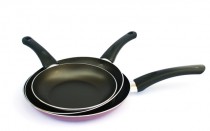A Non-Stick Cookware Released Toxin May be Damaging Your Health
Editor’s note: One of our team members has a close friend who sells top-of-the-line cookware if you are concerned about the health issues discussed in this article. For more information, please write to [email protected]
Mike Barrett
Activist Post
Besides the thought of how difficult it will be to remove food scraps, most give little thought to the pots and pans they use while cooking. One type of cookware which has become very popular in recent years is known as ‘non-stick’ cookware. While this type of cookware can provide a sense of timeliness and convenience due to its non-stick properties, it may actually be endangering the health of you and your family.
Perfluorooctanoic Acid | A Non-Stick Cookware Released Toxin
The toxic fumes emitted from non-stick cookware such as PFOA and polytetrafluoroethylene (PTFE), are actually capable of killing birds. The chemical responsible for the biological damage, which has been shown to cause many problems in animals, has been found in the bloodstream of 95 percent of Americans.
The toxin released by this health-hazardous cookware is known as perfluorooctanoic acid (PFOA), a chemical which has been used for over 70 years in non-stick cookware as well as stain-resistant snack food packaging, microwaved popcorn and cleaning products. It wasn’t until the past few decades, however, that the chemical was recognized as a potential carcinogen at best. Although most of the studies conducted concerning PFOA have been animal studies, they don’t lend any positive support to the chemical.
PFOA isn’t released in the air so much from the non-cookware unless the cookware is heated to a high enough temperature. At a temperature of about 450 degrees Fahrenheit (around Medium on your stove top dial), non-stick cookware begins to release the toxin into the air. This chemical exposure, although not an exceptionally large threat, can cause various health complications like thyroid diseases, low birth weight, or organ specific oxidative DNA damage.
The amount of chemicals we are exposed to on a daily basis is staggering. Toxins from cleaning agents, candles, and carpets contribute to the massive amount of indoor air pollution while various smog-emitting contraptions pump chemicals into the outside air. While avoiding chemical health threats is important, avoiding them all is impossible. Instead of attempting to identify and avoid every toxin in your home, you can instead begin purifying your home to help eliminate a wide variety of indoor toxins.
Don’t stress out over the toxins in your home. Instead, begin eliminating them by cutting down on toxin-emitters like non-stick cookware and synthetic household cleaners. Stress can do a lot more damage than PFOA, and reducing any stress you may currently have is crucial.
RELATED ACTIVIST POST ARTICLE:
4 Simple Ways to Minimize Household Chemicals
Please visit Natural Society for more great health news and vaccine information.


